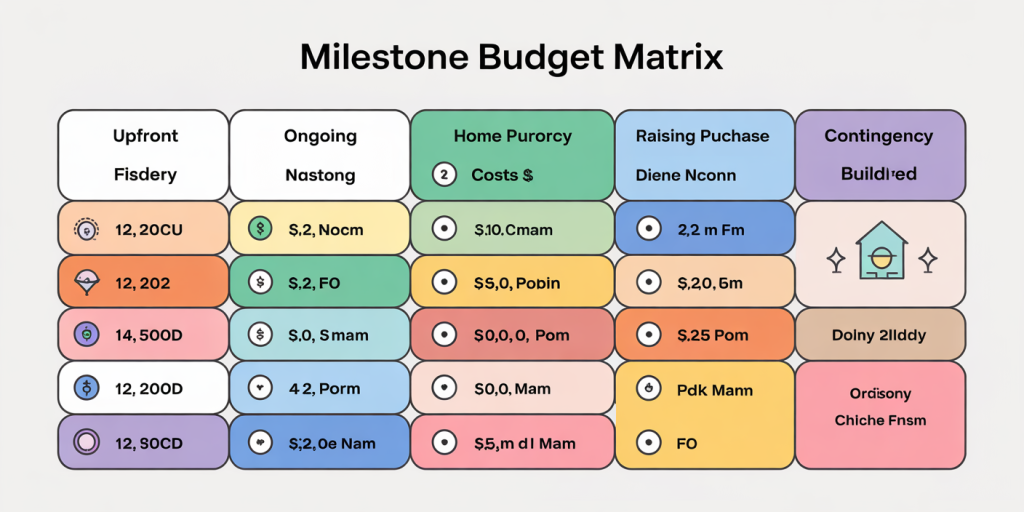Creating a Financial Plan for Life’s Big Moments
Life’s milestones—be it buying a home, starting a family, pursuing higher education, or preparing for retirement—demand significant financial preparation. These defining moments often require a strategic approach to managing resources, balancing immediate needs with future goals. Crafting a robust financial plan for such milestones not only alleviates stress but also maximizes opportunities for wealth accumulation and financial security. According to a 2023 survey by the National Endowment for Financial Education, 63% of adults who engaged in comprehensive financial planning felt more confident in managing major life expenses compared to those who did not.
Strategic financial planning is essential because it provides clarity and control during uncertain times. Sudden expenses or underestimation of costs can derail even the most optimistic aspirations. For example, many Americans underestimate the true cost of homeownership or college tuition, impacting their ability to meet these goals comfortably. This article delves into practical steps and proven strategies for creating a financial plan tailored to life’s major moments, supported by data, real-world examples, and comparative analyses.
—
Recognizing the Financial Impact of Life’s Major Milestones
Understanding the costs associated with key life events is the first step in financial planning. Events such as marriage, buying a house, or having children involve not only large one-time expenses but also ongoing costs that require forethought.
Marriage, for instance, involves wedding expenses, initial household setup, and often merging finances, which can complicate budgeting. Data from The Knot’s 2024 Wedding Report indicates that the average wedding cost in the U.S. exceeds $30,000, a significant financial undertaking. Meanwhile, buying a home carries down payments typically ranging from 3% to 20% of the home price, alongside closing costs, moving expenses, and future maintenance. With median home prices in the U.S. around $400,000 (National Association of Realtors, 2024), the initial outlay can exceed $80,000 including a 20% down payment.
Besides upfront costs, ongoing financial commitments matter. For example, children’s costs from birth through age 18 averages $304,000 per child according to the USDA’s 2023 statistics. These expenses include healthcare, education, food, clothing, and extracurricular activities. Being aware of such figures helps families plan appropriately and avoid surprises.
—
Strategic Budget Allocation for Big Events
Creating a financial plan necessitates allocating budgets realistically for each milestone rather than approximating costs loosely. One effective method is the “milestone budget matrix,” which breaks down each life event’s expenses into three categories: upfront, ongoing, and contingency.

| Life Event | Upfront Costs | Ongoing Costs | Contingency Fund (10-15%) |
|---|---|---|---|
| Wedding | Venue, catering, attire ($30k) | Annual anniversaries & gifts ($1k) | $3,000 – $4,500 |
| Home Purchase | Down payment ($80k), closing fees | Mortgage, property tax, maintenance | $8,000 – $12,000 |
| Raising a Child | Hospital bills, baby gear ($5k) | Education, childcare, health ($15k/year) | $3,000 – $5,000 annually |
This table exemplifies the need for clear financial categories, allowing realistic saving targets and emergency buffers that help absorb unplanned expenses.
Real case: Sarah and John, a couple from Ohio, planned their wedding by setting explicit budgets in each category and saved systematically over two years. Their contingency fund covered unexpected costs such as last-minute dress alterations and venue decoration changes, ensuring no debt was incurred post-wedding.
—
Leveraging Savings and Investment Vehicles
Simple saving strategies alone may not suffice for long-term goals. Using investment vehicles and savings accounts tailored to each milestone helps optimize returns and mitigate risks. For example, employing a 529 college savings plan for children’s education can provide tax advantages and targeted growth.
Emergency funds with liquid accounts are crucial before diving into riskier investments. Ideally, three to six months of living expenses should be liquid and accessible in a high-yield savings account. Once this safety net is solid, individuals can explore vehicles like IRAs for retirement or brokerage accounts for general wealth building.
Using a diversified portfolio that matches the timeline and risk tolerance of each life event will pay dividends. For instance, younger families planning for college can take moderate risks in equities for growth over 10-15 years, while nearing retirement demands safer bonds and cash equivalents.
—
Prioritizing Debt Management for Life’s Financial Events
High-interest debt is a critical barrier to achieving financial milestones. Debt such as credit card balances or payday loans can significantly reduce the capacity to save or invest. According to Experian’s 2024 report, the average American credit card debt stands at approximately $6,300, with an average APR of 17.2%.
Effective debt management involves prioritizing paying off high-interest debts before allocating funds to savings for big events. For example, Maria, a teacher in Texas, initially tried to save for a home down payment while managing $7,000 in credit card debt. After consulting a financial advisor, she paused her home savings for a year to aggressively pay off her credit cards, freeing up funds afterward and improving her mortgage approval chances.
Techniques like the debt avalanche method (paying off highest interest debt first) or debt snowball method (paying the smallest debt first) provide structured approaches. Lowering monthly debt expenses also increases monthly cash flow, redirecting funds towards milestone savings.
—
Insurance and Estate Planning: Protecting Your Financial Milestones
Protecting your financial plan through insurance and estate planning is a vital but often overlooked aspect. Major life events increase financial responsibilities; losing income or encountering unforeseen medical emergencies can cause substantial disruptions.
Health insurance is a major consideration, especially for families with newborns or planned medical procedures. Life insurance becomes essential to secure dependents’ financial future, particularly after marriage or childbirth. Term life insurance is often recommended as an affordable option providing coverage during critical years.
Additionally, estate planning, including wills and trusts, protects assets and ensures they are used according to your wishes. For example, couples with children often establish trusts to manage inheritance and safeguard minors’ financial future.
A 2023 report from the Insurance Information Institute found that 48% of U.S. adults do not have a will or estate plan, exposing families to legal complications in major life transitions.
—
Future Perspectives: Planning for Emerging Financial Challenges
As we move forward, financial planning for big life moments must adapt to evolving economic landscapes and personal circumstances. The impact of inflation, housing market volatility, and changing healthcare costs will demand even more rigorous and flexible approaches.
Technological advancements offer new tools for financial planning, such as AI-driven budgeting apps, robo-advisors for investment management, and platforms for goal tracking. Harnessing these innovative tools can increase accuracy and engagement in financial planning.

Moreover, emerging trends like remote work and gig economy jobs introduce new income streams but also require more sophisticated tax and savings plans. Future planners must integrate these dynamics to maintain resilience.
Demographic shifts, including longer life expectancy, also push individuals to extend retirement planning horizons, integrating healthcare, housing, and legacy planning more thoroughly.
—
Creating a financial plan for life’s big moments is a dynamic and ongoing process that combines careful budgeting, strategic investing, prudent debt management, and risk protection. By understanding costs, allocating budgets with precision, leveraging financial products effectively, and preparing for uncertainties, individuals can confidently navigate milestones that define both personal and financial success.

